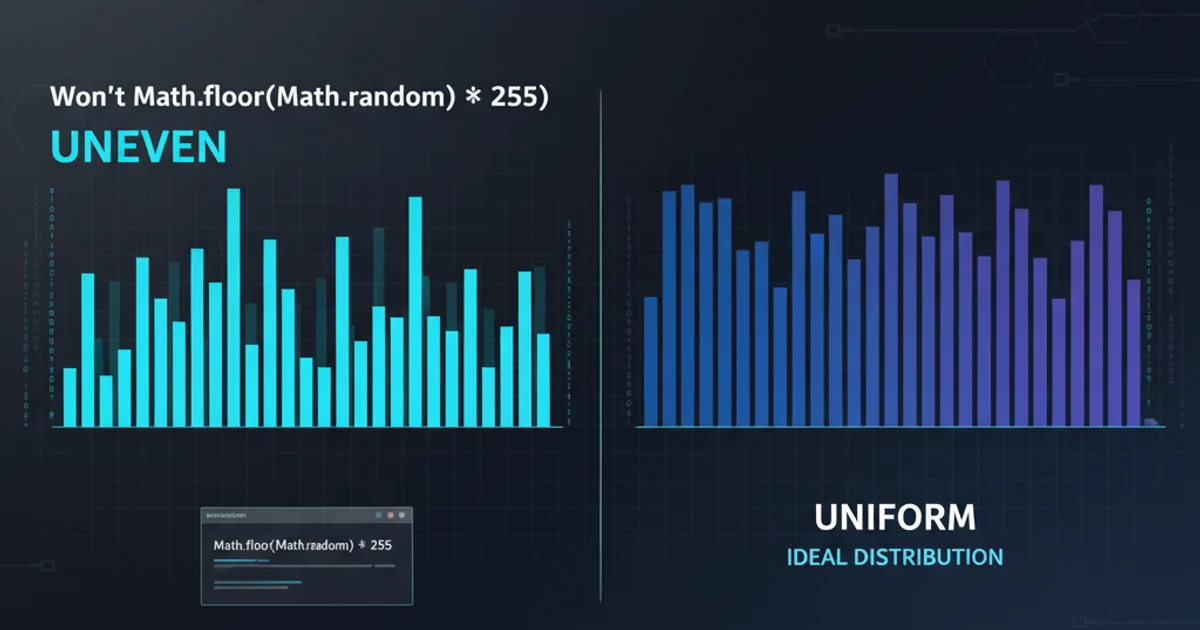Won't Math.floor(Math.random() * 255) generate uneven probabilities?
Categories:
Understanding Probability Distribution with Math.floor(Math.random() * N)

Explore whether Math.floor(Math.random() * 255) generates uneven probabilities and how to achieve a truly uniform distribution for random number generation in JavaScript.
When working with random numbers in JavaScript, a common pattern to generate an integer within a specific range is Math.floor(Math.random() * N). For instance, Math.floor(Math.random() * 255) is often used to get a random integer between 0 and 254, inclusive. However, a subtle but critical question arises: does this method produce a truly even, or uniform, probability distribution across all possible outcomes? This article delves into the mechanics of Math.random() and Math.floor() to uncover potential biases and demonstrate how to ensure fair probability in your applications.
The Mechanics of Math.random() and Math.floor()
To understand the probability distribution, we first need to examine how Math.random() and Math.floor() operate. Math.random() returns a floating-point, pseudo-random number in the range [0, 1), meaning it includes 0 but excludes 1. This is crucial. The numbers generated are uniformly distributed across this continuous range.
When you multiply Math.random() by N (e.g., 255), the range becomes [0, N). For N = 255, the range is [0, 255). This means the possible values are from 0 up to, but not including, 255. So, 254.999... is possible, but 255 is not.
Finally, Math.floor() rounds a number down to the nearest integer. This operation effectively 'bins' the continuous range into discrete integer values. For example:
Math.floor(0.0)toMath.floor(0.999...)all result in0.Math.floor(1.0)toMath.floor(1.999...)all result in1.- ...and so on.
Each integer k in the range [0, N-1] is generated when Math.random() * N falls within the interval [k, k+1). Since Math.random() provides a uniform distribution over [0, 1), and multiplication by N scales this uniformly, each interval [k, k+1) within [0, N) has an equal 'width' or probability mass. Therefore, Math.floor(Math.random() * N) does generate integers from 0 to N-1 with an even probability distribution.
flowchart TD
A["Math.random() (Range: [0, 1))"] --> B["Multiply by N (e.g., 255)"]
B --> C["Resulting Range: [0, N)"]
C --> D["Math.floor()"]
D --> E["Integer Output (Range: [0, N-1])"]
E --> F{"Is probability even?"}
F -- Yes --> G["Each integer has equal chance"]
F -- No --> H["Bias detected"]
style G fill:#afa,stroke:#333,stroke-width:2px
style H fill:#f9f,stroke:#333,stroke-width:2pxFlowchart illustrating the Math.floor(Math.random() * N) process.
The 'Uneven' Probability Misconception
The misconception often arises when developers intend to generate numbers up to and including N (e.g., 255) but use Math.floor(Math.random() * N). In this specific case, Math.floor(Math.random() * 255) will generate integers from 0 to 254. The number 255 will never be generated. If the goal was to include 255, then the distribution would indeed be 'uneven' because 255 is missing, and the other numbers are generated with equal probability.
If you want to generate a random integer between min (inclusive) and max (inclusive), the correct formula is Math.floor(Math.random() * (max - min + 1)) + min. Let's break this down:
max - min + 1: This calculates the total number of possible integers in the desired range. For example, ifmin = 0andmax = 255, then255 - 0 + 1 = 256possible numbers.Math.random() * (max - min + 1): This scalesMath.random()to the range[0, max - min + 1). So, for0to255, it's[0, 256).Math.floor(...): This rounds down, giving integers from0tomax - min(e.g.,0to255).... + min: Finally,minis added to shift the range to[min, max](e.g.,0to255).
So, for a random integer between 0 and 255 (inclusive), you would use Math.floor(Math.random() * 256). This correctly generates 256 distinct values (0 through 255), each with an equal probability of 1/256.
// Generates a random integer from 0 to N-1 (inclusive)
// Example: 0 to 254
function getRandomIntExclusive(N) {
return Math.floor(Math.random() * N);
}
// Generates a random integer from min to max (inclusive)
// Example: 0 to 255
function getRandomIntInclusive(min, max) {
min = Math.ceil(min);
max = Math.floor(max);
return Math.floor(Math.random() * (max - min + 1)) + min;
}
console.log("Random 0-254: ", getRandomIntExclusive(255));
console.log("Random 0-255: ", getRandomIntInclusive(0, 255));
JavaScript functions for generating random integers within specified ranges.
Simulating and Verifying Distribution
To empirically verify the distribution, you can run a simulation. Generate a large number of random integers using the method in question and count the occurrences of each number. If the distribution is uniform, each number should appear approximately the same number of times.
Consider the case of Math.floor(Math.random() * 3). This should generate 0, 1, and 2 with equal probability. If you run this 3000 times, you'd expect approximately 1000 occurrences of each number. If you were to use Math.floor(Math.random() * 255) expecting 0-255, you would find 255 never appears, confirming the 'unevenness' relative to your expectation, but not an inherent bias in the generation of 0-254.
function simulateDistribution(generatorFn, iterations, rangeMax) {
const counts = new Array(rangeMax + 1).fill(0);
for (let i = 0; i < iterations; i++) {
const num = generatorFn();
if (num >= 0 && num <= rangeMax) {
counts[num]++;
}
}
console.log(`\nDistribution for ${iterations} iterations (0-${rangeMax}):`);
counts.forEach((count, index) => {
console.log(`Number ${index}: ${count} (${((count / iterations) * 100).toFixed(2)}%)`);
});
}
// Test case 1: 0 to 254 (exclusive upper bound for Math.random() * 255)
const generator1 = () => Math.floor(Math.random() * 255);
simulateDistribution(generator1, 100000, 254);
// Test case 2: 0 to 255 (inclusive upper bound for Math.random() * 256)
const generator2 = () => Math.floor(Math.random() * 256);
simulateDistribution(generator2, 100000, 255);
Simulation to verify the probability distribution of random number generation.
Math.random() is generally sufficient for most client-side applications, for cryptographic security or high-stakes simulations, consider using window.crypto.getRandomValues() for truly random numbers.